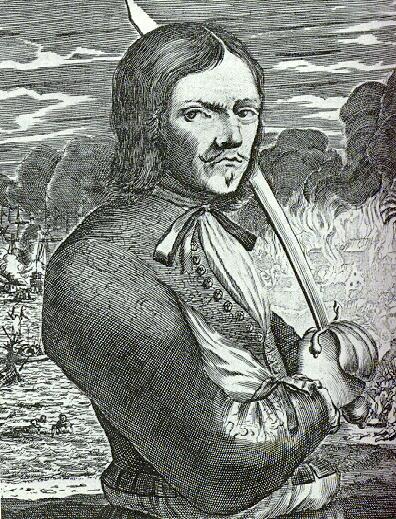The History of Maritime Piracy
Cindy Vallar, Editor & Reviewer
P. O. Box 425, Keller, TX 76244-0425
Cindy Vallar, Editor & Reviewer
P. O. Box 425, Keller, TX 76244-0425
|
|
|
|
|
|
Fléau des Espagnols
Flail of the
Spaniards
By Cindy Vallar

Born in France around 1635, Jean David Nau came to the Caribbean as an indentured servant during the 1650’s. By 1660, however, he had completed his indenture and drifted to St. Domingue where he became a boucanier and eventually, a buccaneer whose career lasted seven years. Fellow pirates called him L’Olonnais. His successes garnered recruits eager to join his expeditions, but his brutality gained him notoriety as one of the cruelest of all pirates.
Most of what we know of L’Olonnais comes from a book, first published in 1678, entitled The Buccaneers of America by Alexandre Oliver Exquemelin. Like L’Olonnais, Exquemelin came to the islands as an indentured servant. From his last master, he learned the skills of a surgeon. He later sailed with Henry Morgan. Unlike L’Olonnais, Exquemelin retired from piracy to become a naval surgeon and wrote about his adventures with the buccaneers. His accounts of L’Olonnais, however, come from the sole survivor of an Indian attack that cost L’Olonnais his life in 1668 or 1669.Early in his career, L’Olonnais became shipwrecked off the coast of Campeche. On shore Spanish soldiers attacked the pirates, killing all save L’Olonnais. Although wounded, he escaped by rubbing blood and sand over his body and then burying himself amongst the dead. After the Spaniards returned to Campeche, L’Olonnais made his way to the city wearing a disguise. Several slaves aided him in his escape and he sailed home to Tortuga.
While Spaniards celebrated his supposed death, he and his crew of pirates held a town for ransom. When the governor of Havana sent a ship to rescue the town, L’Olonnais and his pirates captured the rescuers. He cut off the heads of all but one soldier so that the survivor could deliver a message to the governor: I shall never henceforward give quarter to any Spaniard whatsoever. It was an oath L’Olonnais kept, which was why Spanish seamen preferred to fight to the death or go down with their sinking ship rather than surrender.
In 1667, L’Olonnais sailed from Tortuga with at least six hundred fellow pirates aboard eight ships. En route to Maracaibo, they took a Spanish prize laden with 40,000 pieces of eight, jewels, and a rich cargo of cacao. Upon reaching their destination, they captured the sixteen-gun fort that protected the lagoon by approaching it from land rather than sea before descending on Maracaibo. Forewarned, the residents fled the city, but the buccaneers hunted down the citizens and brought them back to L’Olonnais, who tortured them until they revealed where they had hidden their wealth.
After two weeks the buccaneers headed for the wealthier city of Gibraltar. Although the garrison there outnumbered them, the pirates were victorious with losses of seventy killed or wounded compared to the five hundred Spaniards who died. For a month, L’Olonnais and his men plundered the city and surrounding countryside, netting 260,000 pieces of eight, gems, silverplate, silks, and slaves. Still not satisfied, the buccaneers returned to Maracaibo and demanded an additional ransom of 20,000 pieces of eight and five hundred cows, which the citizens paid. When the pirates divided their booty, each man received the equivalent of more than one hundred pieces of eight.
Word of the successful raids spread throughout St. Domingue and Tortuga. Later that year, when L’Olonnais mounted another expedition, seven hundred buccaneers went on account with him. After capturing Puerto Cavello, L’Olonnais and three hundred pirates headed for San Pedro where Spanish soldiers ambushed the buccaneers. Seeking a clear path into the city, L’Olonnais tortured the soldiers until they told him how to gain entry without encountering another ambush. “He drew his cutlass, and with it cut open the breast of one of those poor Spaniards, and pulling out his heart with his sacrilegious hands, began to bite and gnaw it with his teeth, like a ravenous wolf, saying to the rest: I will serve you all alike, if you show me not another way.”
L’Olonnais was a master torturer. Not only did he burn his victims or cut out their tongues, but when he began cutting them to pieces, he started with a slice of flesh, progressed to a hand, then an arm, and finally a leg. He favored the practice of “woolding,” where he tied a cord around his victim’s eyes and tightened the cord by twisting it with a stick until the man’s eyes popped out of his head.
Soon after attacking Puerto Cavello, the buccaneers split. Most headed back to Tortuga, but L’Olonnais continued his hunt for treasure. Near the islands of De Las Pertas in the Gulf of Honduras, his ship went aground on a sandbar. Unable to dislodge the ship, the buccaneers built a smaller vessel using the wood from the grounded ship.
L’Olonnais and his men eventually landed on the coast of Cartagena where the Indians of Darien captured the pirates. [They] tore him in pieces alive, throwing his body limb by limb into the fire and his ashes into the air. The cruelest of the buccaneers met a fitting end and the Dariens insured that no trace nor memory might remain of such infamous, inhuman creature.
© 2001 Cindy Vallar
Home Pirate Articles Pirate Links Book Reviews Thistles & Pirates